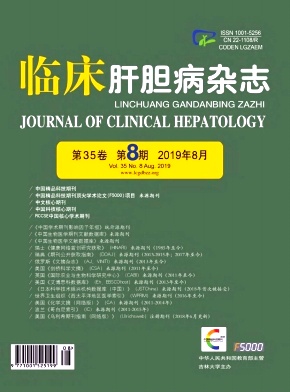|
[1] LIU JQ, ZHOU SM. Research advances in intestinal flora in nonalcoholic fatty liver disease[J]. J Clin Hepatol, 2017, 33 (12) :2453-2456. (in Chinese) 刘嘉琪, 周少明.非酒精性脂肪性肝病肠道菌群的研究进展[J].临床肝胆病杂志, 2017, 33 (12) :2453-2456.
|
|
[2] WIEST R, LAWSON M, GEUKING M. Pathological bacterial translocation in liver cirrhosis[J]. J Hepatol, 2014, 60 (1) :197-209.
|
|
[3] OIKONOMOU T, PAPATHEODORIDIS GV, SAMARKOS M, et al. Clinical impact of microbiome in patients with decompensated cirrhosis[J]. World J Gastroenterol, 2018, 24 (34) :3813-3820.
|
|
[4] ZHANG J, FENG Z, LIU P, et al. Research advances in the association between gut microbiota and complications after liver transplantation[J]. Ogran Transplantation, 2017, 8 (5) :399-401. (in Chinese) 张静, 冯哲, 刘鹏, 等.肠道菌群与肝移植相互作用研究进展[J].器官移植, 2017, 8 (5) :399-401.
|
|
[5] LU BJ, ZHAO YH, AN YT, et al. Research advances in gut microbiota in liver cirrhosis and related complications[J]. J Clin Hepatol, 2018, 34 (11) :2433-2437. (in Chinese) 鲁冰洁, 赵亚红, 安泳潼, 等.肠道微生物在肝硬化及相关并发症中的研究进展[J].临床肝胆病杂志, 2018, 34 (11) :2433-2437.
|
|
[6] SPADONI I, ZAGATO E, BERTOCCHI A, et al. A gut-vascular barrier controls the systemic dissemination of bacteria[J].Science, 2015, 350 (6262) :830-834.
|
|
[7] FOUTS DE, TORRALBA M, NELSON KE, et al. Bacterial translocation and changes in the intestinal microbiome in mouse models of liver disease[J]. J Hepatol, 2012, 56 (6) :1283-1292.
|
|
[8] ASSIMAKOPOULOS SF, TSAMANDAS AC, TSIAOUSSIS GI, et al. Altered intestinal tight junctions’expression in patients with liver cirrhosis:A pathogenetic mechanism of intestinal hyperpermeability[J]. Eur J Clin Invest, 2012, 42 (4) :439-446.
|
|
[9] KARTHIKEYAN A, MOHAN P, CHINNAKALI P, et al. Elevated systemic zonula occludens 1 is positively correlated with inflammation in cirrhosis[J]. Clin Chim Acta, 2018, 480:193-198.
|
|
[10] RAPARELLI V, BASILI S, CARNEVALE R, et al. Low-grade endotoxemia and platelet activation in cirrhosis[J]. Hepatology, 2017, 65 (2) :571-581.
|
|
[11] RAM AK, POTTAKAT B, VAIRAPPAN B. Increased systemic zonula occludens 1 associated with inflammation and independent biomarker in patients with hepatocellular carcinoma[J]. BMC Cancer, 2018, 18 (1) :572.
|
|
[12] ARAB JP, MARTIN-MATEOS RM, SHAH VH. Gut-liver axis, cirrhosis and portal hypertension:The chicken and the egg[J]. Hepatol Int, 2018, 12 (Suppl 1) :24-33.
|
|
[13] TSIAOUSSIS GI, PAPAIOANNOU EC, KOUREA EP, et al. Expression ofα-defensins, CD20+B-lymphocytes, and intraepithelial CD3+T-lymphocytes in the intestinal mucosa of patients with liver cirrhosis:Emerging mediators of intestinal barrier function[J]. Dig Dis Sci, 2018, 63 (10) :2582-2592.
|
|
[14] SHI H, LV L, CAO H, et al. Bacterial translocation aggravates CCl4-induced liver cirrhosis by regulating CD4+T cells in rats[J]. Sci Rep, 2017, 7:40516.
|
|
[15] WANG S, CHARBONNIER LM, NOVAL RIVAS M, et al. My D88adaptor-dependent microbial sensing by regulatory T cells promotes mucosal tolerance and enforces commensalism[J]. Immunity, 2015, 43 (2) :289-303.
|
|
[16] MUOZ L, BORRERO MJ, U'BEDA M, et al. Intestinal immune dysregulation driven by dysbiosis promotes barrier disruption and bacterial translocation in rats with cirrhosis[J]. Hepatology, 2018.[Epub ahead of print]
|
|
[17] HARTMANN P, CHEN P, WANG HJ, et al. Deficiency of intestinal mucin-2 ameliorates experimental alcoholic liver disease in mice[J]. Hepatology, 2013, 58 (1) :108-119.
|
|
[18] TELTSCHIK Z, WIEST R, BEISNER J, et al. Intestinal bacterial translocation in rats with cirrhosis is related to compromised Paneth cell antimicrobial host defense[J]. Hepatology, 2012, 55 (4) :1154-1163.
|
|
[19] WANG J, HUANG N, XIONG J, et al. Caprylic acid and nonanoic acid upregulate endogenous host defense peptides to enhance intestinal epithelial immunological barrier function via histone deacetylase inhibition[J]. Int Immunopharmacol, 2018, 65:303-311.
|
|
[20] U'BEDA M, LARIO M, MUOZ L, et al. Obeticholic acid reduces bacterial translocation and inhibits intestinal inflammation in cirrhotic rats[J]. J Hepatol, 2016, 64 (5) :1049-1057.
|
|
[21] SINGH J, METRANI R, SHIVANAGOUDRA SR, et al. Review on bile acids:Effects of the gut microbiome, interactions with dietary fiber, and alterations in the bioaccessibility of bioactive compounds[J]. J Agric Food Chem, 2019.[Epub ahead of print]
|
|
[22] LU LG, HU JF. Research advances in the association between gut microbiota and bile acid[J]. J Intern Med Concepts Pract, 2018, 13 (6) :329-333. (in Chinese) 陆伦根, 胡江峰.肠道菌群与胆汁酸的研究进展[J].内科理论与实践, 2018, 13 (6) :329-333.
|
|
[23] KAKIYAMA G, PANDAK WM, GILLEVET PM, et al. Modulation of the fecal bile acid profile by gut microbiota in cirrhosis[J]. J Hepatol, 2013, 58 (5) :949-955.
|
|
[24] GIANNELLI V, DI GREGORIO V, IEBBA V, et al. Microbiota and the gut-liver axis:Bacterial translocation, inflammation and infection in cirrhosis[J]. World J Gastroenterol, 2014, 20 (45) :16795-16810.
|
|
[25] RIDLON JM, ALVES JM, HYLEMON PB, et al. Cirrhosis, bile acids and gut microbiota:Unraveling a complex relationship[J]. Gut Microbes. 2013. 4 (5) :382-387.
|
|
[26] BAJAJ JS, HEUMAN DM, HYLEMON PB, et al. Altered profile of human gut microbiome is associated with cirrhosis and its complications[J]. J Hepatol, 2014, 60 (5) :940-947.
|
|
[27] SARANGI AN, GOEL A, SINGH A, et al. Faecal bacterial microbiota in patients with cirrhosis and the effect of lactulose administration[J]. BMC Gastroenterol, 2017, 17 (1) :125.
|
|
[28] MASLENNIKOV R, PAVLOV C, IVASHKIN V. Small intestinal bacterial overgrowth in cirrhosis:Systematic review and meta-analysis[J]. Hepatol Int, 2018, 12 (6) :567-576.
|
|
[29] THEOCHARIDOU E, DHAR A, PATCH D. Gastrointestinal motility disorders and their clinical implications in cirrhosis[J].Gastroenterol Res Pract, 2017, 2017:8270310.
|
|
[30] TETZ GV, RUGGLES KV, ZHOU H, et al. Bacteriophages as potential new mammalian pathogens[J]. Sci Rep, 2017, 7 (1) :7043.
|
|
[31] YANG AM, INAMINE T, HOCHRATH K, et al. Intestinal fungi contribute to development of alcoholic liver disease[J]. J Clin Invest, 2017, 127 (7) :2829-2841.
|









 本站查看
本站查看




 DownLoad:
DownLoad: